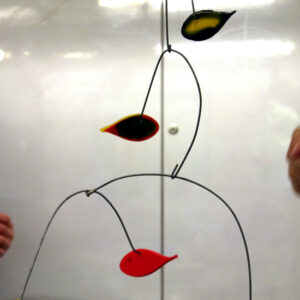Talking Points: Alexander Calder
A range of sources designed to help you explore the work of sculptor, Alexander Calder.
Please note that this page contains links to external websites and has videos from external websites embedded. At the time of creating, AccessArt checked all links to ensure content is appropriate for teachers to access. However external websites and videos are updated and that is beyond our control.
Please let us know if you find a 404 link, or if you feel content is no longer appropriate.
We strongly recommend as part of good teaching practice that teachers watch all videos and visit all websites before sharing with a class. On occasion there may be elements of a video you would prefer not to show to your class and it is the teacher’s responsibility to ensure content is appropriate. Many thanks.
This resource is free to access and is not a part of AccessArt membership.



Alexander Calder
Alexander Calder (July 22, 1898 – November 11, 1976) was an American sculptor known both for his innovative mobiles (kinetic sculptures powered by motors or air currents) that embrace chance in their aesthetic, his static “stabiles”, and his monumental public sculptures. Calder preferred not to analyse his work, saying, “Theories may be all very well for the artist himself, but they shouldn’t be broadcast to other people.” – Wikipedia
Explore his work at the Calder Foundation.
Calder at the Tate.
Discussion & Sketchbook Work
Watch the video below to introduce children to the idea of “mobiles”. Stop the video frequently and use discussion to help children understand the ideas in the video. In particular draw the children’s’ attention to:
-
The idea of slowing down
-
The relationship of the elements to natural objects
-
The relationship of a moving sculpture to dance and music.
Throughout the process, have sketchbooks open on desks with plenty of drawing materials, and pause during the conversations so that pupils can make visual notes.
Watch the video below to introduce children to the idea of “mobiles”. Stop the video frequently and use discussion to help children understand the ideas in the video. In particular draw the children’s’ attention to the idea of “trial and error” (or as we call is Design through Making) as a way of constructing the mobiles.
Throughout the process, have sketchbooks open on desks with plenty of drawing materials, and pause during the conversations so that pupils can make visual notes.
Sketchbook Development Work
Turn the sound down on the video below, and choose certain frames to stop the video so that pupils can make drawings in their sketchbooks based upon the compositions they see.
At first, you as teacher can choose the freeze frame, but then let the pupils make their own choices.
Encourage them to think of the paper of their sketchbook as the “stage” and invite them to draw the shapes, lines and colours they see, thinking carefully about the white space of the page as well as the shapes they draw.
Invite them to use a variety of different materials to capture the shapes. In particular you might want to invite them to use soft B pencils or graphite sticks in one drawing for example, handwriting pen in another, charcoal or collage in another….
Encourage them to work with momentum – for example tell them the film will be frozen for 1 minute/5 minutes etc. Set a clock and invite them to draw, before moving on.
Spend time looking at the drawings they create and invite them to share their thoughts:
-
What did they think when they were drawing Calder’s mobiles? How did they make them feel?
-
What do they think when they see the shapes they have drawn? What do they remind them off?



